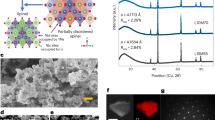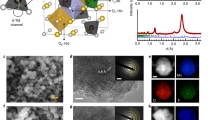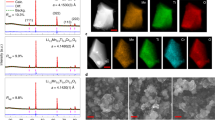Abstract
High-entropy (HE) ceramics, by analogy with HE metallic alloys, are an emerging class of solid solutions composed of a large number of species. These materials offer the benefit of large compositional flexibility and can be used in a wide variety of applications, including thermoelectrics, catalysts, superionic conductors and battery electrodes. We show here that the HE concept can lead to very substantial improvements in performance in battery cathodes. Among lithium-ion cathodes, cation-disordered rocksalt (DRX)-type materials are an ideal platform within which to design HE materials because of their demonstrated chemical flexibility. By comparing a group of DRX cathodes containing two, four or six transition metal (TM) species, we show that short-range order systematically decreases, whereas energy density and rate capability systematically increase, as more TM cation species are mixed together, despite the total metal content remaining fixed. A DRX cathode with six TM species achieves 307 mAh g−1 (955 Wh kg−1) at a low rate (20 mA g−1), and retains more than 170 mAh g−1 when cycling at a high rate of 2,000 mA g−1. To facilitate further design in this HE DRX space, we also present a compatibility analysis of 23 different TM ions, and successfully synthesize a phase-pure HE DRX compound containing 12 TM species as a proof of concept.
This is a preview of subscription content, access via your institution
Access options
Access Nature and 54 other Nature Portfolio journals
Get Nature+, our best-value online-access subscription
$29.99 / 30 days
cancel any time
Subscribe to this journal
Receive 12 print issues and online access
$259.00 per year
only $21.58 per issue
Buy this article
- Purchase on Springer Link
- Instant access to full article PDF
Prices may be subject to local taxes which are calculated during checkout




Similar content being viewed by others
Data availability
All relevant data within the article are available from the corresponding authors on reasonable request. Source data are provided with this paper.
References
Cantor, B., Chang, I. T. H., Knight, P. & Vincent, A. J. B. Microstructural development in equiatomic multicomponent alloys. Mater. Sci. Eng. A 375-377, 213–218 (2004).
Yeh, J. W. et al. Nanostructured high‐entropy alloys with multiple principal elements: novel alloy design concepts and outcomes. Adv. Eng. Mater. 6, 299–303 (2004).
Zhang, R.-Z. & Reece, M. J. Review of high entropy ceramics: design, synthesis, structure and properties. J. Mater. Chem. A 7, 22148–22162 (2019).
Oses, C., Toher, C. & Curtarolo, S. High-entropy ceramics. Nat. Rev. Mater. 5, 295–309 (2020).
Zhang, R.-Z., Gucci, F., Zhu, H., Chen, K. & Reece, M. J. Data-driven design of ecofriendly thermoelectric high-entropy sulfides. Inorg. Chem. 57, 13027–13033 (2018).
Batchelor, T. A. A. et al. High-entropy alloys as a discovery platform for electrocatalysis. Joule 3, 834–845 (2019).
Bérardan, D., Franger, S., Meena, A. & Dragoe, N. Room temperature lithium superionic conductivity in high entropy oxides. J. Mater. Chem. A 4, 9536–9541 (2016).
Wang, Q. et al. Multi-anionic and-cationic compounds: new high entropy materials for advanced Li-ion batteries. Energy Environ. Sci. 12, 2433–2442 (2019).
Sarkar, A. et al. High entropy oxides for reversible energy storage. Nat. Commun. 9, 3400 (2018).
Zhao, C., Ding, F., Lu, Y., Chen, L. & Hu, Y.-S. High‐entropy layered oxide cathodes for Na‐ion batteries. Angew. Chem. Int. Ed. 59, 264–269 (2020).
Harrington, T. J. et al. Phase stability and mechanical properties of novel high entropy transition metal carbides. Acta Mater. 166, 271–280 (2019).
Rost, C. M. et al. Entropy-stabilized oxides. Nat. Commun. 6, 8485 (2015).
Lee, J. et al. Unlocking the potential of cation-disordered oxides for rechargeable lithium batteries. Science 343, 519–522 (2014).
Urban, A., Lee, J. & Ceder, G. The configurational space of rocksalt‐type oxides for high‐capacity lithium battery electrodes. Adv. Energy Mater. 4, 1400478 (2014).
Clément, R. J., Lun, Z. & Ceder, G. Cation-disordered rocksalt transition metal oxides and oxyfluorides for high energy lithium-ion cathodes. Energy Environ. Sci. 13, 345–373 (2020).
Ji, H. et al. Hidden structural and chemical order controls lithium transport in cation-disordered oxides for rechargeable batteries. Nat. Commun. 10, 592 (2019).
Lun, Z. et al. Design principles for high-capacity Mn-based cation-disordered rocksalt cathodes. Chem 6, 153–168 (2020).
Clément, R. J., Kitchaev, D., Lee, J. & Gerbrand, C. Short-range order and unusual modes of nickel redox in a fluorine-substituted disordered rocksalt oxide lithium-ion cathode. Chem. Mater. 30, 6945–6956 (2018).
Ouyang, B. et al. Effect of fluorination on lithium transport and short-range order in disordered-rocksalt-type lithium-ion battery cathodes. Adv. Energy Mater. 10, 1903240 (2020).
Urban, A., Abdellahi, A., Dacek, S., Artrith, N. & Ceder, G. Electronic-structure origin of cation disorder in transition-metal oxides. Phys. Rev. Lett. 119, 176402 (2017).
Chen, R. et al. Disordered lithium-rich oxyfluoride as a stable host for enhanced Li+ intercalation storage. Adv. Energy Mater. 5, 1401814 (2015).
Lee, J. et al. Reversible Mn2+/Mn4+ double redox in lithium-excess cathode materials. Nature 556, 185–190 (2018).
Lun, Z. et al. Improved cycling performance of Li-excess cation-disordered cathode materials upon fluorine substitution. Adv. Energy Mater. 9, 1802959 (2019).
De Ridder, R., van Tendeloo, G. & Amelinckx, S. A cluster model for the transition from the short-range order to the long-range order state in f.c.c. based binary systems and its study by means of electron diffraction. Acta Crystallogr. Sect. A 32, 216–224 (1976).
Hata, S., Matsumura, S., Kuwano, N. & Oki, K. Short range order and its transformation to long range order in Ni4Mo. Acta Materialia 46, 881–892 (1998).
Balasubramanian, M., McBreen, J., Davidson, I., Whitfield, P. & Kargina, I. In situ X-ray absorption study of a layered manganese-chromium oxide-based cathode material. J. Electrochem. Soc. 149, A176–A184 (2002).
Yoon, W.-S. et al. Investigation of the charge compensation mechanism on the electrochemically Li-ion deintercalated Li1-xCo1/3Ni1/3Mn1/3O2 electrode system by combination of soft and hard X-ray absorption spectroscopy. J. Am. Chem. Soc. 127, 17479–17487 (2005).
Luo, K. et al. Charge-compensation in 3d-transition-metal-oxide intercalation cathodes through the generation of localized electron holes on oxygen. Nat. Chem. 8, 684–691 (2016).
Seo, D.-H. et al. The structural and chemical origin of the oxygen redox activity in layered and cation-disordered Li-excess cathode materials. Nat. Chem. 8, 692–697 (2016).
Yang, W. & Devereaux, T. P. Anionic and cationic redox and interfaces in batteries: advances from soft X-ray absorption spectroscopy to resonant inelastic scattering. J. Power Sources 389, 188–197 (2018).
Dai, K. et al. High reversibility of lattice oxygen redox quantified by direct bulk probes of both anionic and cationic redox reactions. Joule 3, 518–541 (2019).
Jones, M. A. et al. Short-range ordering in a battery electrode, the ‘cation-disordered’ rocksalt Li1.25Nb0.25Mn0.5O2. Chem. Commun. 55, 9027–9030 (2019).
Hewston, T. A. & Chamberland, B. L. A survey of first-row ternary oxides LiMO2 (M = Sc-Cu). J. Phys. Chem. Solids 48, 97–108 (1987).
Wu, E. J., Tepesch, P. D. & Ceder, G. Size and charge effects on the structural stability of LiMO2 (M= transition metal) compounds. Phil. Mag. B 77, 1039–1047 (1998).
Kitchaev, D. A. et al. Design principles for high transition metal capacity in disordered rocksalt Li-ion cathodes. Energy Environ. Sci. 11, 2159–2171 (2018).
Lee, J. et al. A new class of high capacity cation-disordered oxides for rechargeable lithium batteries: Li–Ni–Ti–Mo oxides. Energy Environ. Sci. 8, 3255–3265 (2015).
Yabuuchi, N. et al. Origin of stabilization and destabilization in solid-state redox reaction of oxide ions for lithium-ion batteries. Nat. Commun. 7, 13814 (2016).
Yabuuchi, N. et al. P2-type Nax[Fe1/2Mn1/2]O2 made from earth-abundant elements for rechargeable Na batteries. Nat. Mater. 11, 512–517 (2012).
Ji, H. et al. Ultrahigh power and energy density in partially ordered lithium-ion cathode materials. Nat. Energy 5, 213–221 (2020).
Degen, T., Sadki, M., Bron, E., König, U. & Nénert, G. The HighScore suite. Powder Diffrac. 29, S13–S18 (2014).
Coelho, A. Topas Academic version 4.1 (Coelho Software, 2007).
TopSpin Academic version 3.6.2 (Bruker Software, 2019).
O’Dell, L. A., Rossini, A. J. & Schurko, R. W. Acquisition of ultra-wideline NMR spectra from quadrupolar nuclei by frequency stepped WURST–QCPMG. Chem. Phys. Lett. 468, 330–335 (2009).
Pell, A. J., Clément, R. J., Grey, C. P., Emsley, L. & Pintacuda, G. Frequency-stepped acquisition in nuclear magnetic resonance spectroscopy under magic angle spinning. J. Chem. Phys. 138, 114201 (2013).
Sananes, M., Tuel, A., Hutchings, G. & Volta, J. Characterization of different precursors and activated vanadium phosphate catalysts by 31P NMR spin echo mapping. J. Catal. 148, 395–398 (1994).
Massiot, D. et al. 71Ga and 69Ga nuclear magnetic resonance study of β-Ga2O3: resolution of four-and six-fold coordinated Ga sites in static conditions. Solid State Nucl. Magn. Reson. 4, 241–248 (1995).
Ravel, B. & Newville, M. ATHENA, ARTEMIS, HEPHAESTUS: data analysis for X-ray absorption spectroscopy using IFEFFIT. J. Synchrotron Radiat. 12, 537–541 (2005).
Wu, J. et al. Elemental-sensitive detection of the chemistry in batteries through soft X-ray absorption spectroscopy and resonant inelastic X-ray scattering. J. Visual. Exp. 134, e57415 (2018).
McCloskey, B. D., Bethune, D., Shelby, R., Girishkumar, G. & Luntz, A. Solvents’ critical role in nonaqueous lithium–oxygen battery electrochemistry. J. Phys. Chem. Lett. 2, 1161–1166 (2011).
McCloskey, B. D. et al. On the efficacy of electrocatalysis in nonaqueous Li–O2 batteries. J. Am. Chem. Soc. 133, 18038–18041 (2011).
McCloskey, B. D. et al. Twin problems of interfacial carbonate formation in nonaqueous Li–O2 batteries. J. Phys. Chem. Lett. 3, 997–1001 (2012).
Renfrew, S. E. & McCloskey, B. D. Residual lithium carbonate predominantly accounts for first cycle CO2 and CO outgassing of Li-stoichiometric and Li-rich layered transition-metal oxides. J. Am. Chem. Soc. 139, 17853–17860 (2017).
Kresse, G. & Joubert, D. From ultrasoft pseudopotentials to the projector augmented-wave method. Phys. Rev. B 59, 1758–1775 (1999).
Kresse, G. & Furthmüller, J. Efficiency of ab-initio total energy calculations for metals and semiconductors using a plane-wave basis set. Comput. Mater. Sci. 6, 15–50 (1996).
Dudarev, S. L., Botton, G. A., Savrasov, S. Y., Humphreys, C. J. & Sutton, A. P. Electron-energy-loss spectra and the structural stability of nickel oxide: an LSDA+U study. Phys. Rev. B 57, 1505–1509 (1998).
Wang, L., Maxisch, T. & Ceder, G. Oxidation energies of transition metal oxides within the GGA+U framework. Phys. Rev. B 73, 195107 (2006).
Zunger, A., Wei, S. H., Ferreira, L. G. & Bernard, J. E. Special quasirandom structures. Phys. Rev. Lett. 65, 353–356 (1990).
Shin, D., van de Walle, A., Wang, Y. & Liu, Z.-K. First-principles study of ternary fcc solution phases from special quasirandom structures. Phys. Rev. B 76, 144204 (2007).
Wei, S. H., Ferreira, L. G., Bernard, J. E. & Zunger, A. Electronic properties of random alloys: special quasirandom structures. Phys. Rev. B 42, 9622–9649 (1990).
Urban, A., Matts, I., Abdellahi, A. & Ceder, G. Computational design and preparation of cation-disordered oxides for high-energy-density Li-ion batteries. Adv. Energy Mater. 6, 1600488 (2016).
Abdellahi, A., Urban, A., Dacek, S. & Ceder, G. The effect of cation disorder on the average Li intercalation voltage of transition-metal oxides. Chem. Mater. 28, 3659–3665 (2016).
Abdellahi, A., Urban, A., Dacek, S. & Ceder, G. Understanding the effect of cation disorder on the voltage profile of lithium transition-metal oxides. Chem. Mater. 28, 5373–5383 (2016).
Hautier, G., Fischer, C., Ehrlacher, V., Jain, A. & Ceder, G. Data mined ionic substitutions for the discovery of new compounds. Inorg. Chem. 50, 656–663 (2011).
Sanchez, J. M., Ducastelle, F. & Gratias, D. Generalized cluster description of multicomponent systems. Phys. A 128, 334–350 (1984).
Wolverton, C. & de Fontaine, D. Cluster expansions of alloy energetics in ternary intermetallics. Phys. Rev. B 49, 8627–8642 (1994).
Nelson, L. J., Hart, G. L. W., Zhou, F. & Ozoliņš, V. Compressive sensing as a paradigm for building physics models. Phys. Rev. B 87, 035125 (2013).
Richards, W. D., Dacek, S. T., Kitchaev, D. A. & Ceder, G. Fluorination of lithium‐excess transition metal oxide cathode materials. Adv. Energy Mater. 8, 1701533 (2018).
Ji, H. et al. Computational investigation and experimental realization of disordered high-capacity Li-ion cathodes based on Ni redox. Chem. Mater. 31, 2431–2442 (2019).
Cowley, J. M. X‐Ray measurement of order in single crystals of Cu3Au. J. Appl. Phys. 21, 24–30 (1950).
Acknowledgements
This work was supported by Umicore Specialty Oxides and Chemicals, the Assistant Secretary for Energy Efficiency and Renewable Energy, Vehicle Technologies Office of the US Department of Energy (DOE) under contract no. DEAC02-05CH11231, under the Advanced Battery Materials Research (BMR) Program. Work at the Molecular Foundry was supported by the Office of Science and Office of Basic Energy Sciences of the US DOE under contract no. DE-AC02-05CH11231. The NMR experimental work reported here made use of the shared facilities of the UCSB MRSEC (NSF DMR 1720256), a member of the Material Research Facilities Network. This research used resources at the Spallation Neutron Source, a DOE Office of Science User Facility operated by the Oak Ridge National Laboratory. This research used resources from beamline 28-ID of the National Synchrotron Light Source II, a US DOE Office of Science User Facility operated for the DOE Office of Science by Brookhaven National Laboratory under contract no. DE-SC0012704. Work at the Advanced Light Source is supported by the US DOE Office of Science User Facility under contract no. DE-AC02-05CH11231. This research used resources of the Advanced Photon Source, an Office of Science User Facility operated for the US DOE Office of Science by Argonne National Laboratory, and was supported by the US DOE under contract no. DE-AC02-06CH11357. The computational analysis was performed using computational resources sponsored by the US DOE Office of Energy Efficiency and Renewable Energy and located at the National Renewable Energy Laboratory, and computational resources were provided by Extreme Science and Engineering Discovery Environment (XSEDE), which was supported by National Science Foundation grant no. ACI1053575, as well as the National Energy Research Scientific Computing Center (NERSC), a DOE Office of Science User Facility supported by the Office of Science and the US DOE under contract no. DE-AC02-05CH11231. The authors thank J. Liu for help with the neutron diffraction measurements.
Author information
Authors and Affiliations
Contributions
Z.L. planned the project with H. J. and G.C. Z.L. designed, synthesized, characterized (XRD) and electrochemically tested the proposed compounds with the help from Z.C., J.H., Haegyeom Kim and H.J. B.O. performed DFT, SQS calculations, cluster expansion and Monto Carlo simulations and analysed the data. D.-H.K. acquired and analysed TEM data. Y.H. acquired and analysed the RIXS data with W.Y. E.E.F. acquired and analysed the NMR data with R.J.C. T.-Y.H. acquired and analysed DEMS data with input from B.D.M. Z.L. acquired and analysed the XAS data with the help from Hyunchul Kim, M.B., Z.C. and Y.S. Y.T. performed the SEM. The manuscript was written by Z.L. and revised by B.O., R.J.C., H.J. and G.C. with the help of all other authors. All authors contributed to discussions.
Corresponding authors
Ethics declarations
Competing interests
The authors declare no competing interests.
Additional information
Publisher’s note Springer Nature remains neutral with regard to jurisdictional claims in published maps and institutional affiliations.
Supplementary information
Supplementary Information
Supplementary Figs. 1–20, Notes 1–7, Tables 1 and 2 and references.
Source data
Source Data Fig. 1
Synchrotron XRD and TEM electron diffraction SRO intensity profile.
Source Data Fig. 2
Electrochemical performance.
Source Data Fig. 3
X-ray absorption spectroscopy at Cr, Mn and Co K-edge.
Source Data Fig. 4
Calculated mixing temperatures and lab XRD result for TM12.
Rights and permissions
About this article
Cite this article
Lun, Z., Ouyang, B., Kwon, DH. et al. Cation-disordered rocksalt-type high-entropy cathodes for Li-ion batteries. Nat. Mater. 20, 214–221 (2021). https://doi.org/10.1038/s41563-020-00816-0
Received:
Accepted:
Published:
Issue Date:
DOI: https://doi.org/10.1038/s41563-020-00816-0
This article is cited by
-
The new car batteries that could power the electric vehicle revolution
Nature (2024)
-
The rise of high-entropy battery materials
Nature Communications (2024)
-
High-entropy materials for energy and electronic applications
Nature Reviews Materials (2024)
-
Re-evaluation of battery-grade lithium purity toward sustainable batteries
Nature Communications (2024)
-
Enhanced cyclic stability of partially disordered spinel cathodes through direct fluorination with gaseous fluorine
Rare Metals (2024)



